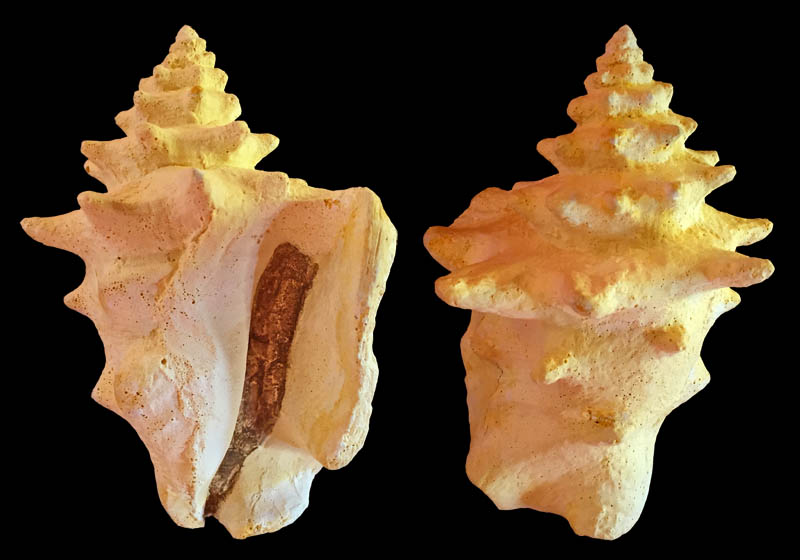Species / Persististrombus Gijskronenbergi
Stromboidea
Original diagnosis:
- "A moderately large-sized, thick-shelled, slender strombid with high spire. Teleoconch whorls sculptured by a single row of very large and long spines; bodywhorl with 3 rows of spines and weaker spiral ribs. Wide wing with deep posterior notch and prominent posterior tip."
Original description of Strombus gijskronenbergi by Harzhauser, 2007:
- "Biconical, slender shell with high spire with an apical angle of 47° and a bodywhorl of about 33°; protoconch unknown. Teleoconch consisting of 9 strongly angulated teleoconch whorls with up to 9 prominent spines of subtrigonal cross-section. Earliest teleoconch whorls bear characteristic varices separated by 4-5 angulated axial ribs. Suture regular, straight, thread-like. The interspaces, where the bases of the spines merge, form a sharp angulation, separating a flat to feebly concave ramp from the contracting abapical part of the whorls. Bodywhorl sculptured with a row of 7- 9 very large and long spines along the shoulder and two additional but slightly weaker rows of spines. The entire shell surface bears a sculpture of spiral ribs, separated by broader interspaces. Those ribs covering also the spines, are slightly more prominent, being best developed on the lower side of the spines. In juvenile specimens the spiral ornament consists of dense spiral threads. The wide wing contrasts with the slender shape; it expands quite abruptly and forms a concavity between wing and bodywhorl. The sculpture of the last whorl persists to the lip. On the inner surface, the position of the rows of spines is reflected as shallow furrows. Stromboid notch very deep and well developed, forming a narrow up to 2 cm deep canal. Siphonal canal similarly deep and narrow, terminating in a strongly deflected canal. An additional deep posterior notch separates the bodywhorl from the protruding tip of the wing."
Locus typicus: Gebel Madrakah, Oman
Stratum typicus: bioclastic limestones of the Ghubbarah Formation, Aquitanian, Miocene
Holotype: NHMW, No. 2006z0231/0030; width 64 mm, height 116 mm.
Original comment of Harzhauser:
- Strombus gijskronenbergi differs from the probably related Strombus bernielandaui in its larger size, the longer bodywhorl and the long spines on the lower part of the bodywhorl. This species is the most frequent mollusc in the Ghubbarah Formation at Gebel Madrakah, but was undetected in the underlying Warak Formation. All shells are dissolved in the limestone of the Ghubbarah Formation. Therefore, only casts and silicone moulds are available. Steinkern specimens from the Oligo/Miocene of Somalia, reported as Strombus cf. nodosus Borson by Azzaroli (1958), might also represent Strombus gijskronenbergi. Poorly preserved steinkerns from the Miocene of Kenya discussed by Cox (1930) might be a further but doubtful hint to an Arabian-East-African distribution of this species. Its absence in the well-known Western Tethys faunas of Italy and France suggests that Strombus gijskronenbergi is a southern Tethys element which never migrated into the north-west. It is unknown from the eastern faunas of Borneo or Java as well. Only the much younger strombid from the Late Miocene of Guam, determined as Strombus cf. preoccupatus Finlay 1921 by Ladd (1972), is similar in size and sculpture. It differs mainly in the higher teleoconch whorls and the prominent spiral grooves in the adapical part of the whorls.

Strombus gijskronenbergi (Harzhauser, 2007); Paratype; Ghubbarah Formation, Aquitanian, Miocene; Gebel Madrakah, Oman; Coll. NHMW, No. 2006z0231/0031
Specimens in private collections
Persistitrombus gijskronenbergi (Harzhauser, 2007), cast; topotype; Ghubbarah Formation, Aquitanian, Miocene; Gebel Madrakah, Oman; Coll. Ulrich Wieneke
References:


